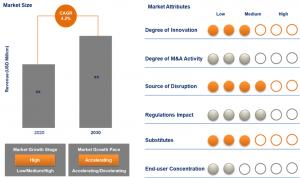US fire pump market is projected to reach USD 641.8 million by 2030 growing at a CAGR of 4.2%
The "US Fire Pump Market by Type, by Rating, by Power Source, by Product Type, by End Use and by States - Forecast to 2030" report by Tersus Strategy
MILWAUKEE, WISCONSIN, USA, September 12, 2022 /EINPresswire.com/ -- The "US Fire Pump Market by Type (Horizontal Split Case, Vertical Split Case, Vertical In-Line, Vertical Turbine and End-Suction), by Rating (Up to 500 gpm, 500 to 1,000 gpm, 1000 to 1,500 gpm and Above 1,500 gpm), by Power Source (Fuel Powered , Electric Powered and Hybrid), by Product Type (Portable Fire Pumps, Fixed Fire Pumps and Skid Fire Pumps), by End Use (Residential, Commercial and Industrial) and by States - Forecast to 2030" report has been added to Tersus Strategy’s offering.
As manufacturing industries expand, fire hazards at industrial sites have heightened in equal proportion. The risks of fire outbreaks are especially high across chemical manufacturing, petroleum extraction and oil & gas industries. According to estimates by the International Association of Fire and Rescue Services, there were more than 1.3 million cases of fires reported in the United States.
On the back of these trends, the demand for fire pumps across these sectors is anticipated to be the maximum in the next half-a-decade’s forecast period.
A fire pumps is a type of special motor-driven application that is an essential component of building safety systems. They are required to be installed by the U.S. (NSPA 20) building regulations. During a fire, fire pumps are used to keep the water pressure in the sprinklers and standpipes at the required level. Building codes also specify where fire pump engines and fire pump controllers are required to be set up.
Building codes are becoming stricter with rising urbanization and infrastructure progress. Growing population concentration has also forced governments to focus more on human safety, thereby driving consumption of fire pumps in the U.S.
The U.S. dollar has continually strengthened over the last 12 months straight, and this has reduced the price of imports in the country. However, it has negatively impacted exports, and U.S. products exported might struggle to hold on to their market share with the strengthening of the dollar.
Request detailed sample of the study: https://tersusstrategy.com/product/global-us-fire-pump-market-2022-2030/
Hybrid fire pumps segment, by power source, is projected to grow at highest CAGR during the forecast period: Usage of hybrid fire pumps has experienced an upward thrust. While electric pumps do result in major cost savings, several difficulties may arise while using it. The most important barrier to using electric pumps is the constant electricity supply it requires.
In case of power failure, electric pumps cannot be used. In this scenario, a hybrid pump which runs on both electricity and diesel is highly desirable. Whenever there is a power outage, users can simply switch over to the diesel mode, rendering it in working condition should an emergency arise.
Horizontal Split Case segment, by type, is projected to dominate the market during the forecast period: Horizontal split case pumps are used extensively in both, industrial as well as real estate applications. High efficiency, low maintenance, long operation life, among others, are factors driving horizontal split case fire pump demand.
For more information about this report visit: https://tersusstrategy.com/product/global-us-fire-pump-market-2022-2030/
Key Topics Covered:
1. Report Scope
1.1. Market Segmentation and scope
1.2. Regional Scope
1.3. Estimates and forecast timeline
2. Market Research Methodology
2.1. Research methodology and design
2.2. Sample selection
2.3. Reliability and validity
3. Executive Summary
4. Market Analysis
4.1. Market size and growth rates
4.2. Market growth drivers, market dynamics and trends
4.3. Market scenarios and opportunity forecasts
4.4. Market constraints and challenges
4.5. Industry value chain analysis
4.6. Industry analysis – Porter’s
4.6.1. Threat of new entrants
4.6.2. Bargaining power of suppliers
4.6.3. Bargaining power of buyers
4.6.4. Threat of substitutes
4.6.5. Competitive rivalry
4.7. PEST analysis
4.7.1. Political/legal landscape
4.7.2. Economic landscape
4.7.3. Social landscape
4.7.4. Technological landscape
5. Market Breakdown – by Type
5.1. Introduction
5.2. Horizontal Split Case
5.3. Vertical Split Case
5.4. Vertical In-Line
5.5. Vertical Turbine
5.6. End-Suction
6. Market Breakdown – by Rating
6.1. Introduction
6.2. Up to 500 gpm
6.3. 500 to 1,000 gpm
6.4. 1000 to 1,500 gpm
6.5. Above 1,500 gpm
7. Market Breakdown – by Power Source
7.1. Introduction
7.2. Fuel Powered
7.3. Electric Powered
7.4. Hybrid
8. Market Breakdown – by Product Type
8.1. Introduction
8.2. Portable Fire Pumps
8.3. Fixed Fire Pumps
8.4. Skid Fire Pumps
9. Market Breakdown – by End-User
9.1. Introduction
9.2. Residential
9.3. Commercial
9.3.1. Educational Institutions
9.3.2. Corporate Offices
9.3.3. Lodging, Multiplex and Amusement Park
9.3.4. Airport, Rail, and Metro Stations
9.3.5. Others
9.4. Industrial
9.4.1. Petroleum Refining
9.4.2. Metals and Mining
9.4.3. Automotive and Transportation
9.4.4. Chemicals
9.4.5. Pulp and Paper
9.4.6. Electrical and Electronics
9.4.7. Pharmaceuticals
9.4.8. Others
10. Market Breakdown – by Geography
10.1. California
10.2. Texas
10.3. New York
10.4. Florida
10.5. Illinois
10.6. Pennsylvania
10.7. Ohio
10.8. Washington
10.9. Georgia
10.10. New Jersey
10.11. North Carolina
10.12. Massachusetts
10.13. Virginia
10.14. Michigan
10.15. Maryland
10.16. Colorado
10.17. Minnesota
10.18. Indiana
10.19. Arizona
10.20. Tennessee
10.21. Wisconsin
10.22. Missouri
10.23. Connecticut
10.24. Others
11. Competitive Landscape
11.1. Company Market Positioning
11.2. Company Geographical Presence Analysis
11.3. Market Revenue Share Analysis (%), by Leading Players
12. Company Profiles
• Company Overview
• Financial Performance
• Product Benchmarking
• Recent Developments
12.1. Armstrong Fluid Company
12.2. Peerless Pump Company
12.3. Xylem Inc.
12.4. Pentair Ltd.
12.5. Ruhrpumpen
12.6. Wilo SE
12.7. W.S. Darley & Co
12.8. IDEX Corporation
12.9. Patterson Pump Company (Gorman-Rupp)
12.10. Waterous Co.
12.11. Talco Fire Systems
12.12. Schutte & Koerting
For more information about this report visit: https://tersusstrategy.com/product/global-us-fire-pump-market-2022-2030/
Kevin Matthew
Tersus Strategy
+1 414.882.8941
email us here


